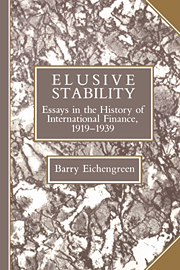Book contents
- Frontmatter
- Contents
- List of tables
- List of figures
- Acknowledgments
- 1 Introduction
- 2 Real exchange rate behavior under alternative international monetary regimes
- 3 Understanding 1921–1927: inflation and economic recovery in the 1920s
- 4 Bank Rate policy under the interwar gold standard
- 5 The Bank of France and the sterilization of gold, 1926–1932
- 6 International policy coordination in historical perspective: a view from the interwar years
- 7 The economic consequences of the franc Poincaré
- 8 Sterling and the tariff, 1929–1932
- 9 Exchange rates and economic recovery in the 1930s
- 10 The gold-exchange standard and the Great Depression
- 11 Hegemonic stability theories of the international monetary system
- References
- Index
10 - The gold-exchange standard and the Great Depression
Published online by Cambridge University Press: 21 March 2010
- Frontmatter
- Contents
- List of tables
- List of figures
- Acknowledgments
- 1 Introduction
- 2 Real exchange rate behavior under alternative international monetary regimes
- 3 Understanding 1921–1927: inflation and economic recovery in the 1920s
- 4 Bank Rate policy under the interwar gold standard
- 5 The Bank of France and the sterilization of gold, 1926–1932
- 6 International policy coordination in historical perspective: a view from the interwar years
- 7 The economic consequences of the franc Poincaré
- 8 Sterling and the tariff, 1929–1932
- 9 Exchange rates and economic recovery in the 1930s
- 10 The gold-exchange standard and the Great Depression
- 11 Hegemonic stability theories of the international monetary system
- References
- Index
Summary
Two broad approaches dominate the literature on macroeconomics of the Great Depression. One, associated mainly with studies of the United States, emphasizes misguided policy responses at the national level as an explanation for the Depression's singular depth and long duration. The other, with a long tradition but associated prominently with the work of Charles Kindleberger, emphasizes instead the malfunctioning of the international system. The strength of the first approach is the transparency of the propagation mechanism, usually taken to be deflationary monetary trends. The weakness of the second is precisely the opposite, that the propagation mechanism tends to be opaque. It is not clear what dimension of the international system malfunctioned after 1929, nor through what channels its malfunctioning contributed to the Depression.
A prime suspect is surely the gold-exchange standard of the interwar years. That system was a hybrid, neither a pure gold standard like that which prevailed in various countries prior to World War I nor a fiat money system like that which succeeded the breakdown of Bretton Woods. As under a gold standard, countries were required to maintain convertibility between domestic currency and gold and to leave international gold movements unfettered. But they were permitted – indeed encouraged – to hold international reserves in the form of foreign exchange. This introduced into the operation of the gold standard “a new psychological element never present before the war.”
- Type
- Chapter
- Information
- Elusive StabilityEssays in the History of International Finance, 1919–1939, pp. 239 - 270Publisher: Cambridge University PressPrint publication year: 1990
- 1
- Cited by



